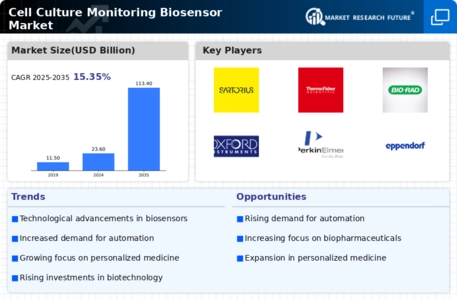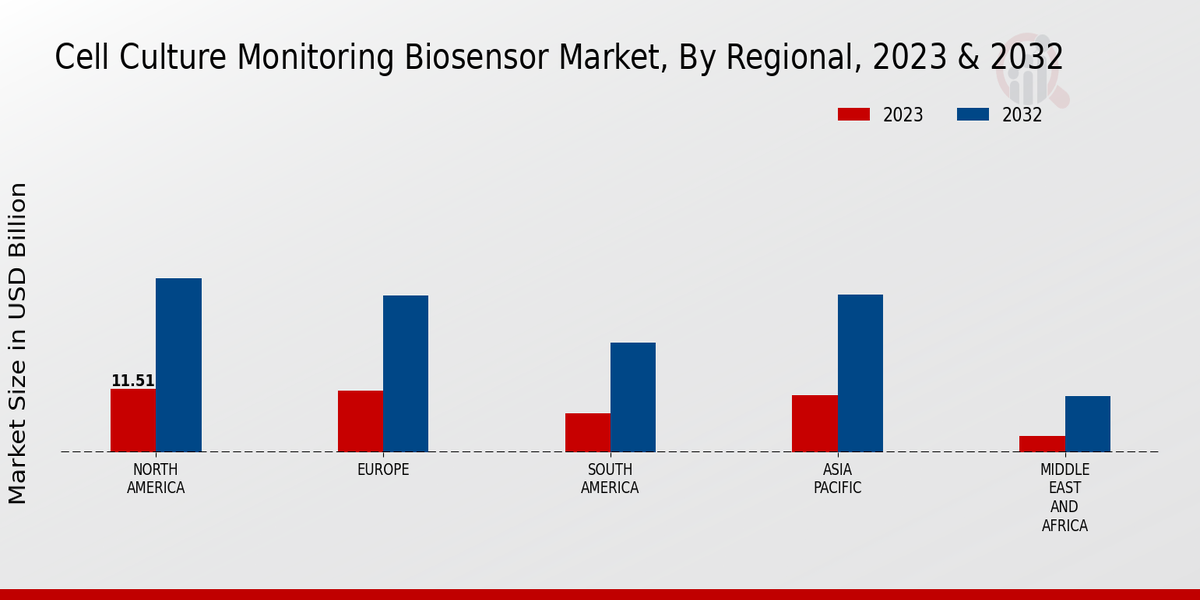Market Growth Projections
The Global Cell Culture Monitoring Biosensor Market Industry is projected to experience substantial growth in the coming years. With a market size expected to reach 23.6 USD Billion in 2024 and an impressive increase to 113.4 USD Billion by 2035, the industry is on a robust upward trajectory. The anticipated compound annual growth rate (CAGR) of 15.35% from 2025 to 2035 underscores the increasing demand for advanced biosensor technologies. This growth is driven by various factors, including the rising demand for biopharmaceuticals, technological advancements, and the growing focus on personalized medicine. These projections indicate a promising future for the Global Cell Culture Monitoring Biosensor Market Industry.
Rising Demand for Biopharmaceuticals
The increasing demand for biopharmaceuticals is a primary driver of the Global Cell Culture Monitoring Biosensor Market Industry. As the biopharmaceutical sector expands, the need for efficient and accurate monitoring of cell cultures becomes critical. This demand is projected to elevate the market size to 23.6 USD Billion in 2024, reflecting the industry's growth trajectory. Biopharmaceuticals, which often require complex cell culture processes, necessitate advanced monitoring solutions to ensure optimal conditions for cell growth and product yield. Consequently, the Global Cell Culture Monitoring Biosensor Market Industry is likely to benefit from this trend, as companies seek innovative biosensor technologies to enhance their production capabilities.
Growing Focus on Personalized Medicine
The shift towards personalized medicine is emerging as a significant driver for the Global Cell Culture Monitoring Biosensor Market Industry. Personalized medicine relies heavily on tailored therapies that require precise cell culture conditions to ensure efficacy and safety. As healthcare systems increasingly adopt personalized approaches, the demand for advanced monitoring solutions is likely to rise. This trend is expected to contribute to the market's expansion, with projections indicating a market size of 113.4 USD Billion by 2035. The ability of biosensors to provide real-time insights into cell behavior and responses is crucial for developing personalized therapies, thereby enhancing the relevance of the Global Cell Culture Monitoring Biosensor Market Industry.
Technological Advancements in Biosensors
Technological advancements in biosensor technology are significantly influencing the Global Cell Culture Monitoring Biosensor Market Industry. Innovations such as real-time monitoring, miniaturization, and integration with artificial intelligence are enhancing the capabilities of biosensors. These advancements allow for more precise and timely data collection, which is essential for optimizing cell culture conditions. As a result, the market is expected to experience a compound annual growth rate (CAGR) of 15.35% from 2025 to 2035. This growth is indicative of the increasing reliance on sophisticated biosensor technologies in various applications, including drug development and regenerative medicine, thereby driving the overall market forward.
Increased Investment in Research and Development
Increased investment in research and development (R&D) within the life sciences sector is propelling the Global Cell Culture Monitoring Biosensor Market Industry. As organizations allocate more resources to R&D, the demand for reliable and efficient biosensors for cell culture monitoring rises. This investment is crucial for advancing scientific knowledge and developing new therapies. The market is poised for growth as funding from both public and private sectors supports innovative research initiatives. This trend not only enhances the capabilities of existing biosensor technologies but also fosters the emergence of novel solutions tailored to specific research needs, thereby driving the overall market forward.
Regulatory Support for Advanced Cell Culture Technologies
Regulatory support for advanced cell culture technologies is a vital driver of the Global Cell Culture Monitoring Biosensor Market Industry. Governments and regulatory bodies are increasingly recognizing the importance of biosensors in ensuring the safety and efficacy of biopharmaceutical products. This support is manifested through streamlined approval processes and funding for research initiatives. As regulations evolve to accommodate new technologies, the market is likely to benefit from enhanced adoption rates of biosensors in various applications. This regulatory environment fosters innovation and encourages investment in biosensor development, ultimately contributing to the growth of the Global Cell Culture Monitoring Biosensor Market Industry.




















Leave a Comment